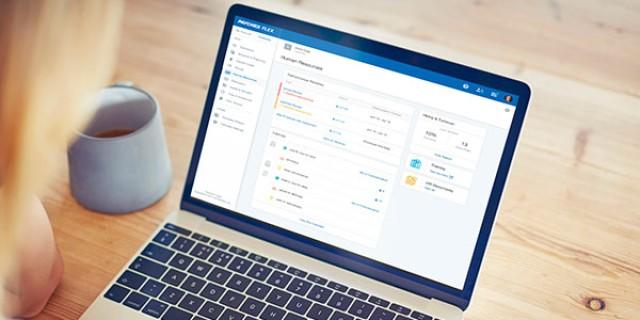- Employee Benefits
- Article
- 6 min. Read
- Last Updated: 01/23/2025
What Is a QSEHRA? Here's What You Need To Know

Table of Contents
Small businesses often struggle to provide affordable healthcare options for their employees, especially in uncertain economic times. According to Paychex's 2025 Priorities for Business Leaders, 86% of leaders identify economic uncertainty as a significant challenge.
A Qualified Small Employer Health Reimbursement Arrangement (QSEHRA) is a flexible IRS-approved plan that allows employers to reimburse employees for individual health insurance premiums and other eligible medical expenses on a pretax basis, creating a flexible and cost-effective alternative to traditional group health plan insurance.
Keep reading to learn more.
How Do QSEHRAs Work?
QSEHRAs provide a way for small businesses to reimburse employees for healthcare costs. Here's how they work:
1. Employer Setup:
- Check eligibility: Employers must have less than 50 full-time equivalent employees and not offer a group health insurance plan.
- Create a formal plan document that outlines the details of the QSEHRA, including reimbursement limits, eligible expenses, and plan terms.
- Notify employees: Employers must provide written notice detailing the annual benefit amount and any tax-related responsibilities at least 90 days before the plan begins.
2. Contribution Limits:
- For 2025, employers can reimburse up to $6,350 for individual coverage and $12,800 for family coverage.
- Employers determine the QSEHRA reimbursement amounts within these limits. Only employer contributions are allowed—employees cannot contribute.
3. Reimbursement Process:
- Employees incur QSEHRA-eligible expenses, such as individual health insurance premiums, out-of-pocket medical costs, or prescription medications.
- Employees submit proof of these expenses, like receipts or invoices, to the employer or a plan administrator.
- Employers review the claims and reimburse employees for approved expenses up to the set limits.
4. How Employees Use Funds:
- Reimbursed funds can be used for qualified medical expenses as IRS Section 213(d) defines.
- Employees must have minimum essential coverage (MEC) to maintain the tax-free status of the reimbursements.
5. Optional Rollovers:
- Employers can choose whether unused QSEHRA funds roll over into the following year. However, even with rollovers, contributions cannot exceed the annual IRS limits.
Employers can offer tax-free benefits through a QSEHRA to help employees manage their healthcare costs while boosting employee engagement and retention.
Frequently Asked Questions About QSEHRA
Here are answers to some common questions about QSEHRAs:
-
Who Is Eligible To Offer a QSEHRA?
Who Is Eligible To Offer a QSEHRA?
Employers may not be an Applicable Large Employer (ALE) to offer individual health insurance coverage under a QSEHRA. This means they employ less than 50 full-time or full-time equivalent employees and are not subject to Affordable Care Act (ACA) coverage requirements. These eligible employers also do not offer their employees group health plans.
-
Who Can Contribute to a QSEHRA?
Who Can Contribute to a QSEHRA?
Like a regular health reimbursement arrangement (HRA), only employers can contribute to it. Employees cannot. Employer contributions are tax-deductible.
-
What Health Expenses Can QSEHRAs Cover?
What Health Expenses Can QSEHRAs Cover?
QSEHRAs can reimburse eligible medical expenses that employees incur, as defined by IRS code 213(d). This includes their premiums for their health insurance policy bought in the individual market, out-of-pocket medical costs, prescription drugs, and more.
-
What's the Advantage of a QSEHRA Over a Regular HRA?
What's the Advantage of a QSEHRA Over a Regular HRA?
HRAs have been popular among small companies because they provide employers with a tax break for reimbursing employees' healthcare costs and can help control overall healthcare spending. However, the ACA limited the use of those plans. It made "standalone" HRAs—those that reimburse health costs only for employees not covered by a group plan—unlawful and assessed them an excise tax of $100 a day per employee.
The QSEHRA plan was created to allow small businesses with fewer than 50 employees to offer a standalone HRA again, reimbursing employees' health care costs on the individual market. Large companies are not eligible.
According to Paychex's 2025 Priorities for Business Leaders survey, 41% of leaders are focused on enhancing employee benefits to attract and retain talent. QSEHRAs directly support this goal by giving small businesses a competitive edge in offering meaningful healthcare support, all while maintaining cost predictability.
-
Do All Eligible Employees Have To Be Included in the QSEHRA?
Do All Eligible Employees Have To Be Included in the QSEHRA?
Regular, full-time employees are eligible for a QSEHRA. Employers can exclude certain types of employees, including part-time and seasonal employees, those with less than 90 days of service, union employees, those under age 25, and nonresident aliens, but they do not have to.
-
What Kind of Notification Requirements Must Employers Follow?
What Kind of Notification Requirements Must Employers Follow?
When offering a new QSEHRA, employers must notify their employees at least 90 days before the start of the plan year or the start of a new employee's eligibility. Employers must include the following information in the notice:
- The annual health benefit amount for each eligible employee
- A notification that employees must report their QSEHRA benefit to the marketplace when applying for premium tax credits (PTC)
- A notification that employees may have to pay taxes on the benefit for any month they fail to maintain health coverage
-
When Was the QSEHRA Created?
When Was the QSEHRA Created?
QSEHRAs were established in 2016 as part of the 21st Century Cures Act, a landmark legislation to advance medical innovation and improve healthcare access. This act created the QSEHRA as a way for small employers to offer a health reimbursement arrangement (HRA) without violating Affordable Care Act (ACA) rules, which had previously restricted standalone HRAs.
The 21st Century Cures Act introduced QSEHRAs, giving small businesses with fewer than 50 full-time equivalent employees a new option for supporting their healthcare needs.
Unlike traditional HRAs tied to group health plans, QSEHRAs allow employers to reimburse employees for individual insurance premiums and medical expenses on a pretax basis. This change offered much-needed flexibility for small employers navigating the complexities and cost of healthcare benefits.
-
Can QSEHRA Funds Roll Over?
Can QSEHRA Funds Roll Over?
QSEHRA funds can roll over, but it's up to the employer. Employers can allow unused QSEHRA reimbursement funds to roll over into the next plan year, so employees have more control over their healthcare costs.
However, the IRS annual limits still apply. For 2025, those are $6,350 for individuals and $12,800 for families, so the total amount reimbursed in a year can't exceed those amounts.
Employers who allow rollovers can make their QSEHRA more attractive by giving employees more time to use their benefits. This will be especially helpful for employees with more significant medical expenses. However, employers need to balance that flexibility with their overall budget and healthcare spending goals, so the plan stays manageable.
-
What Are the Downsides of QSEHRA?
What Are the Downsides of QSEHRA?
While QSEHRAs offer valuable flexibility for small employers, they have some limitations. These drawbacks can make QSEHRAs less suitable in certain situations. Key limitations include:
- Contribution caps: In 2025, the contribution limits of QSEHRAs, which are capped at $6,350 for individuals and $12,800 for families, may not meet the needs of all employees
- No employee contributions: Unlike Health Savings Accounts (HSAs), QSEHRAs are fully employer-funded, limiting employees' ability to save additional funds for medical expenses
- Minimum essential coverage (MEC) requirement: Employees must maintain MEC to receive tax-free reimbursements, which can exclude those without qualifying insurance plans
These limitations make a QSEHRA health insurance plan a strategic option for specific use cases but less versatile than other healthcare benefits. Employers should carefully evaluate whether a QSEHRA aligns with their budget and employees' needs.
Get Help With the Qualified Small Employer HRA
Small businesses can provide their employees with health insurance or help them pay for it. Paychex can educate you, your management staff, and your employees on the health insurance options that best meet your company's needs.
Tags







